1928 Hudson Doors of Mystery
Out of the four doors, none of them will crank up because of rusty mechanisms. It is not apparent to me how to get the winder out from its captive inner panel hole with the glass down. And there are no instructions that I can find because no one has these kind of mechanisms in current cars. I'm hoping that another old car owner can tell me how to proceed. For starters, I squirted a lot of PB Blaster on the available parts, but I suspect there is a rusty roller in a track. My goals are to replace the edge glides, the rubber window seal, and get the mechanism to work before I smash the darn thing to pieces in a fit. I'm really a patient person, but the singular arm angling downward from the center of the large gear will not move on the track(?), so of course nothing will crank up even with the door turned upside down. So far this has been a challenge to fingers. Light does not help, neither do mirrors. But I know that someone out there has the secret slight-of-hand answer to the Doors of Mystery. Oh, I have to get the locks out to free them while I'm tearing everything apart.
Advice, preferably with pictures?
Advice, preferably with pictures?
0
Comments
-
For lack of other replies, here's my two cents.A couple of Hudson's 1926 patents show a bit of the mechanism, and both patent texts also describe the order of assembly. The patents are US1705741 and US1732291 (click for PDFs - unfortunately the latter patent is missing the first page of drawings). If you compare your doors to the drawings and descriptions, hopefully they'll provide some clues.

0 -
If you remove the screws holding the mechanism into the door inner frame you should be able to move the glass up far enough with your fingers, rotating the mechanism in the process. Once the glass is high enough you can then poke the mechanism inwards into the recess. Remove the top frame of the door (three screws) and lift the glass right out the top. Once you have the glass up far enough you should be able to wiggle the end of the arm out of the hole in the end of the bottom slot and remove the winder mechanism. good luck.0
-
Mechanism was rusty, so wouldn't turn to lift it up. Took off the top piece, then turned the door upside down, sprayed PB Blaster and waited. DON'T TAKE OUT THE SCREWS YET. Then juggled the crank back and forth while pushing the arm over and got the window extended. Only a 1/4" of the clip showed. Removed the screws holding the mechanism and pried with a flat blade screwdriver to get the glass extended the rest of the way. Unhooked the roller and everything else came apart easily.
The pinion on the shaft is a loose fit allowing it to jamb somehow so the window doesn't move unless you turn the crank. Clever, but it's all inside a riveted case. Has anyone ever seen the insides with a picture? I would like too know how it works but am not going to take mine apart.0 -
Oh, forgot to say that I had to rip out the glide run, the wool felt and the hardened fractured and misshapen pieces before the glass would move. This let me move the glass side to side a little and free up enough rust that the roller would move on the track.0
-
Now that I'm cutting off the bottom exterior door panel, I see that there is an inner wall, with holes, that traps a thick sheet(s) of felted tarred paper. Slightly flammable, makes a char and smokes a lot when heated. I'm guessing that this was supposed to be sound deadening insulation? Thermal insulation? Should I add more while I'm in there?
There is provision for a rubber lower rain seal on outside of the window glass held by a sheet metal strip and three sheet metal screws. But not the inside?
Looks like water at the lower glass corners will funnel into the inside of the door because the rubber cann't dovetail into the channel glide. There are no drain holes in the door that I can see, so water could build up. This doesn't seem right.0 -
The paper could be the sound deadening material described in patent US1827743 -"All-metal automobile bodies, such as are now quite extensively used, while having distinct advantages from the standpoint of strength, durability, and economy of production over the older types of wooden and composite bodies, have been found to be objectionably noisy in use, due, in part at least, to the resonance of the exterior paneling which is usually curved in configuration corresponding with the desired curved lines of the body. This trouble, while present to a certain extent throughout the body, is particularly noticeable in the case of the doors which, when closed suddenly, give forth an offensive metallic ring.[...] the invention in its broader aspect consists in applying a non-metallic backing to the sheet metal panels to deaden their resonance and thereby prevent the metallic noises characteristic of bodies of this character. In its preferred form the invention consists in the employment of a sheet of non-metallic material overlying the inner face of the outer panel, together with means for holding said sheet in engagement with the panel substantially throughout its area."The sound deadening material is # 21 in the pics, see link above for the full details.
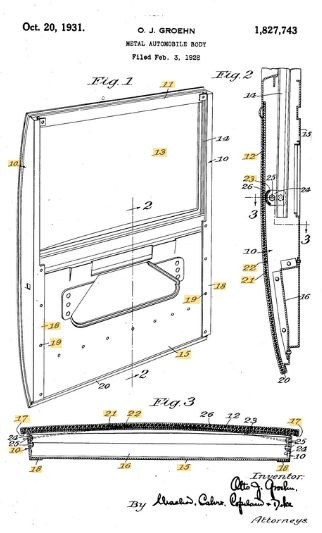
0 -
The second image shows what the inside looks like before the outer skin is cut and removed. The tarred felt shows through the lightening hole in the first inner door panel. The felt is impossible to replace. The door has four metal layers in places shown in the first image.
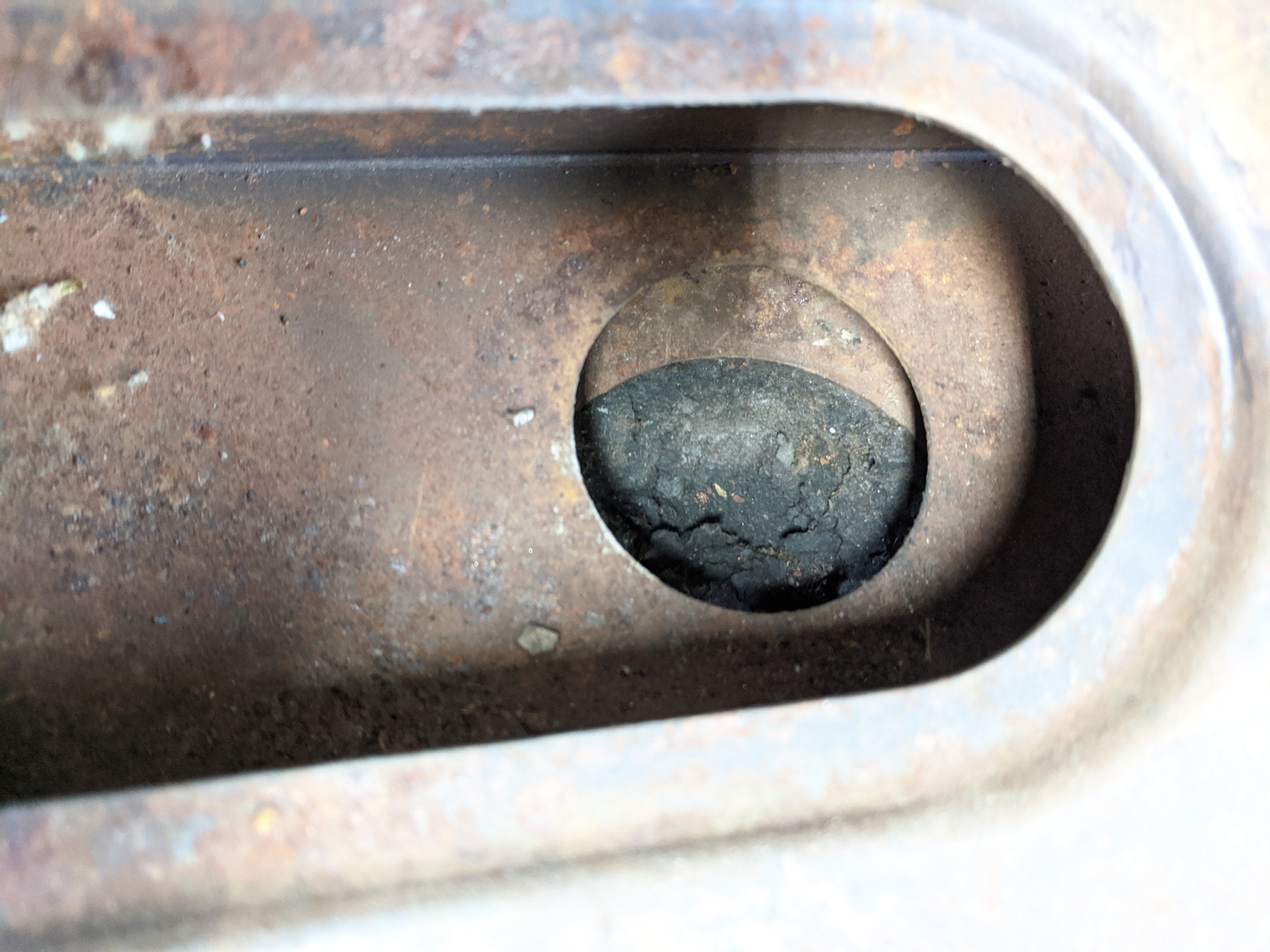
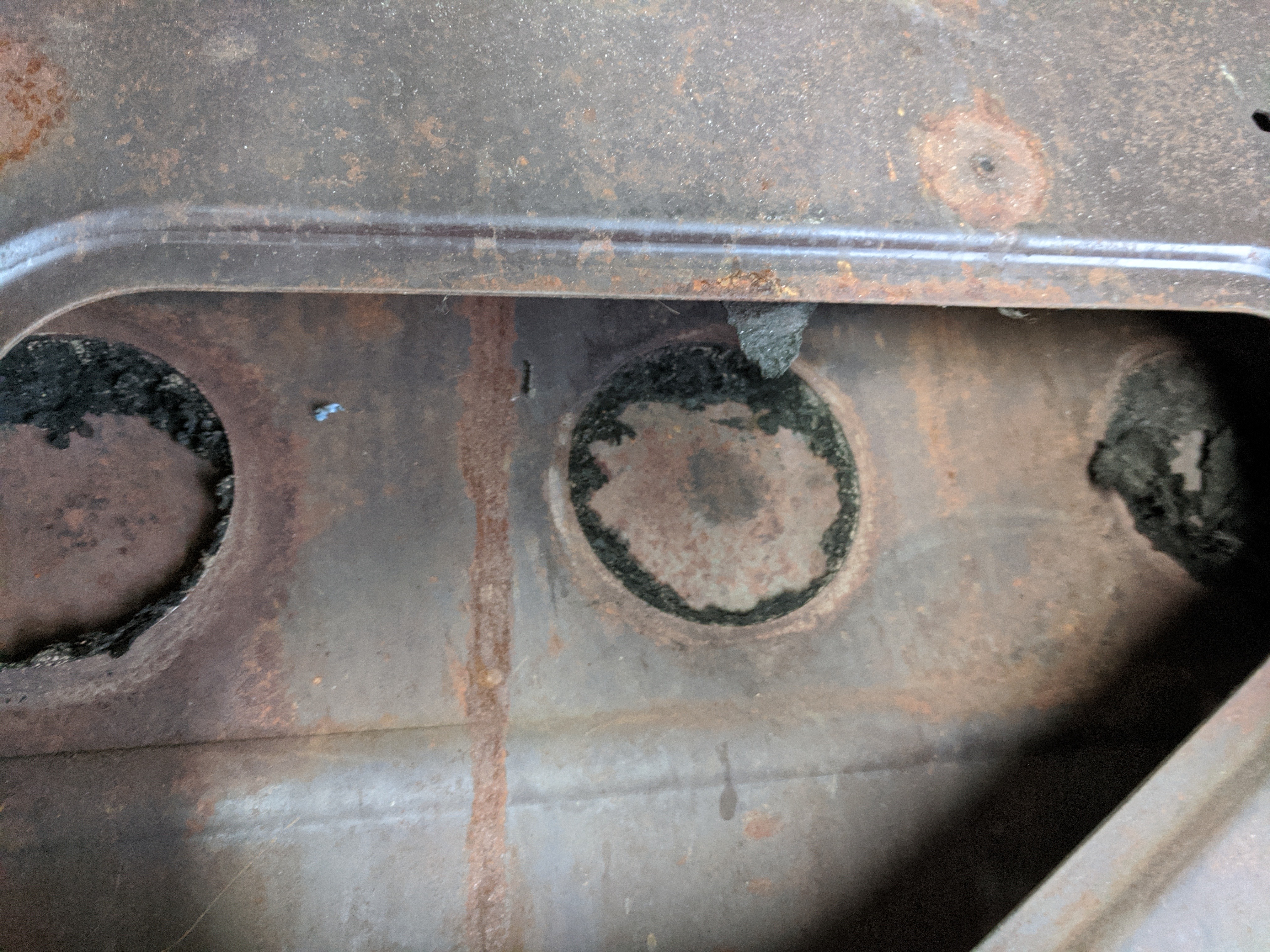 I suspect the little mice that lived under the protective car wrap trimmed the felt, harvesting to stuff inside my engine. 0
I suspect the little mice that lived under the protective car wrap trimmed the felt, harvesting to stuff inside my engine. 0 -
More mystery. Where should I go to buy window clips to fix the windows in the rear doors? This is the channel the fastens to the glass and has the slot for the mechanism roller. These clips in the rear doors are completely destroyed. All I have found so far are Ford parts, and none of them will fit.
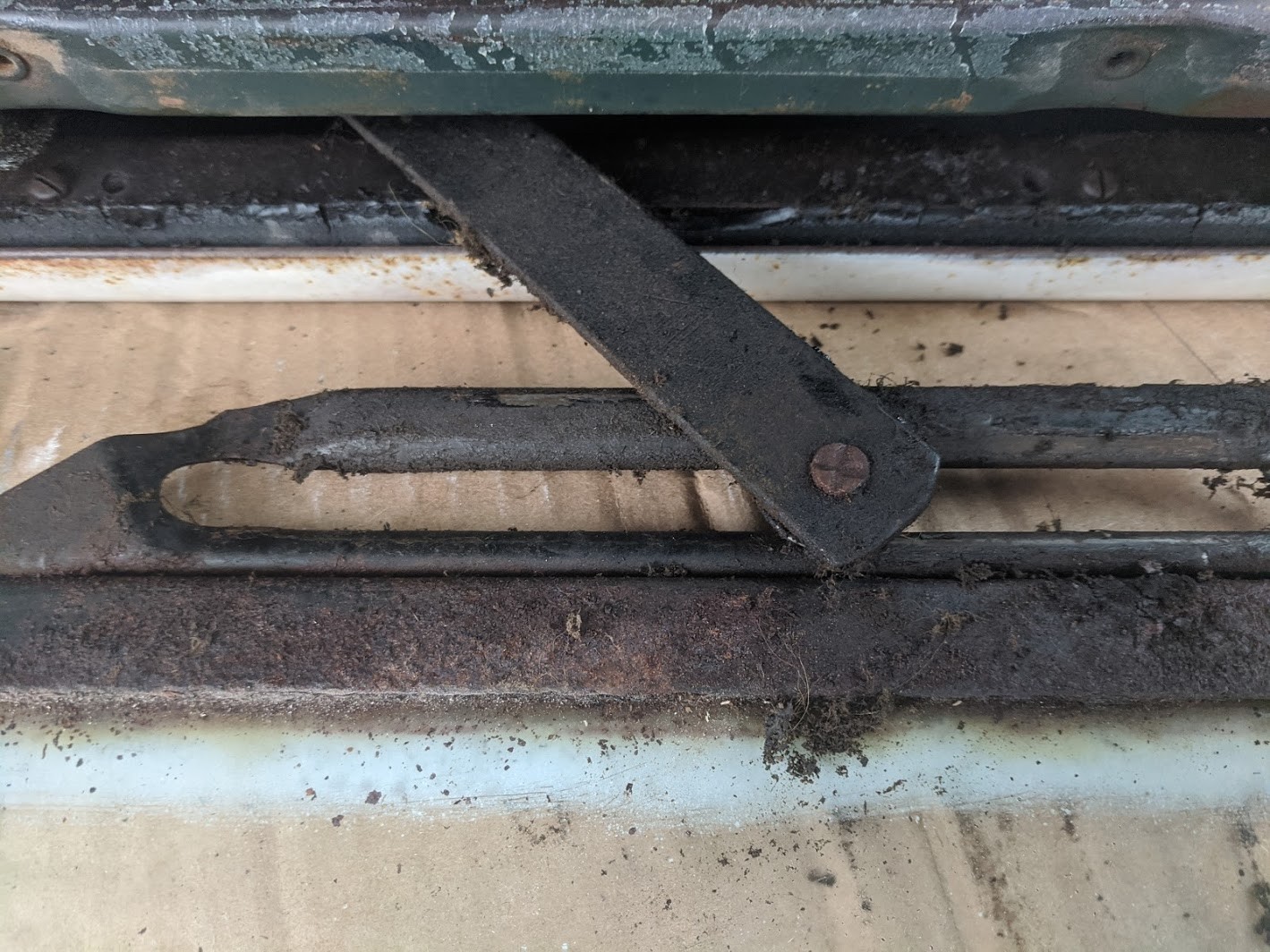 Above is a close-up of the roller in the slot of a good clip, upside down from a front door. The clip is 22-1/4" long.
Above is a close-up of the roller in the slot of a good clip, upside down from a front door. The clip is 22-1/4" long.
BTW, I have found that a diesel fuel soak for a few days does wonders to get rust off.0 -
The driver's door handle has a lock that apparently attaches the lock handle square shaft to the escutcheon plate. When I took out the plate screws, the entire assembly came off, but I don't see any way to remove the corroded cylinder to make a repair.
Functionally, the door remains inaccessible when the door handle is removed. So now, that's the only way to lock my car. I will have to carry the handle around in my pocket, and its not convenient. What else can I do short of riveting a hasp and padlock to the door?
I do recall seeing an image on the old Yahoo site of a door handle under a drill press. I assume that someone had the same issue with the lock that I have. Whatever solution they had is now lost to me. I did find that it is a 5 level wafer cylinder made by the Briggs & Stratton company, made from 1928 pot metal. Contacting several locksmiths was a waste of time. No one will touch the problem nor offer suggestions, and I can't even get a key into the lock. The only suggestion given to me that was even slightly workable was to buy a Ford lock. Ugg. I would hate to do that.0 -
I've been googling a bit, and found some information about Briggs & Stratton that might help when you're looking for a new cylinder.Wikipedia says Briggs & Stratton filed a patent for a five-wafer lock in 1924, and it was first used in the 1924 Hupp Eight. By 1935, they had a six-wafer lock, that GM started using. This account of Briggs & Stratton's history says that "In 1929, Briggs & Stratton shipped more than 11 million locks to approximately 130 manufacturers, including General Motors, Ford, Chrysler and the Dodge Brothers", so it should be possible to find an authentic replacement cylinder and key, even if you have to search outside the Hudson sphere.
 There may have been different models of B&S locks, though - at least they patented a lot of different versions. The same account of B&S history mentions that "In the mid-1920's, the company introduced a line of automotive products referred to as "hardware." This product line included door handles, inside door levers, door knobs, ornamental plates and hinged covers for keyholes. Briggs & Stratton promoted these items as "Automobile Body Hardware of Distinctive Character." During this time, they also created an early brand name "Basco" (Briggs & Stratton Company) that was prominently displayed on all products, advertisements and literature." Maybe there's a chance that Hudson used B&S-made door handles, if you'd need to replace the entire handle?Re Ford, they used a few different brands of door locks, including Briggs & Stratton, around 1928, and it says here that "a Ford change letter dated March 1928 called for the removal of both names (Ford and Briggs and Stratton Corp.) from keys and only the “B” in a diamond remained". So it may be a B&S lock even if it doesn't say so on the key.
There may have been different models of B&S locks, though - at least they patented a lot of different versions. The same account of B&S history mentions that "In the mid-1920's, the company introduced a line of automotive products referred to as "hardware." This product line included door handles, inside door levers, door knobs, ornamental plates and hinged covers for keyholes. Briggs & Stratton promoted these items as "Automobile Body Hardware of Distinctive Character." During this time, they also created an early brand name "Basco" (Briggs & Stratton Company) that was prominently displayed on all products, advertisements and literature." Maybe there's a chance that Hudson used B&S-made door handles, if you'd need to replace the entire handle?Re Ford, they used a few different brands of door locks, including Briggs & Stratton, around 1928, and it says here that "a Ford change letter dated March 1928 called for the removal of both names (Ford and Briggs and Stratton Corp.) from keys and only the “B” in a diamond remained". So it may be a B&S lock even if it doesn't say so on the key.
0 -
When I was playing around with the window winders of my '29 Landau Sedan I found that the felted paper you refer to had detached from the panel and collapsed, obstructing the winder mechanism. The only solution was to remove the trim panel, a process which is fraught with the risk of breaking pot metal components. After pulling the old felt out and cleaning everything those windows went up and down very nicely! The original felt mess was replaced adhesive-backed sound deadening sheeting that worked a treat.0
-
How do I drill out the old tumbler so I can at least turn the handle to open the door? Being that the cylinder is old pot metal, I figure everyone has had this issue and it was such an unpleasant hassle that they don't want to talk about it anymore. I need some advice. Don't make me resort to a Model A Ford replacement, please.0
-
I found this on eBay. Could this be the lock? This looks like it has a raised dome top, unlike the Hudson lock. Manufactured by Vintique, part number B-7121984 1928/48 pass & pickup door lock cylinder and keys.
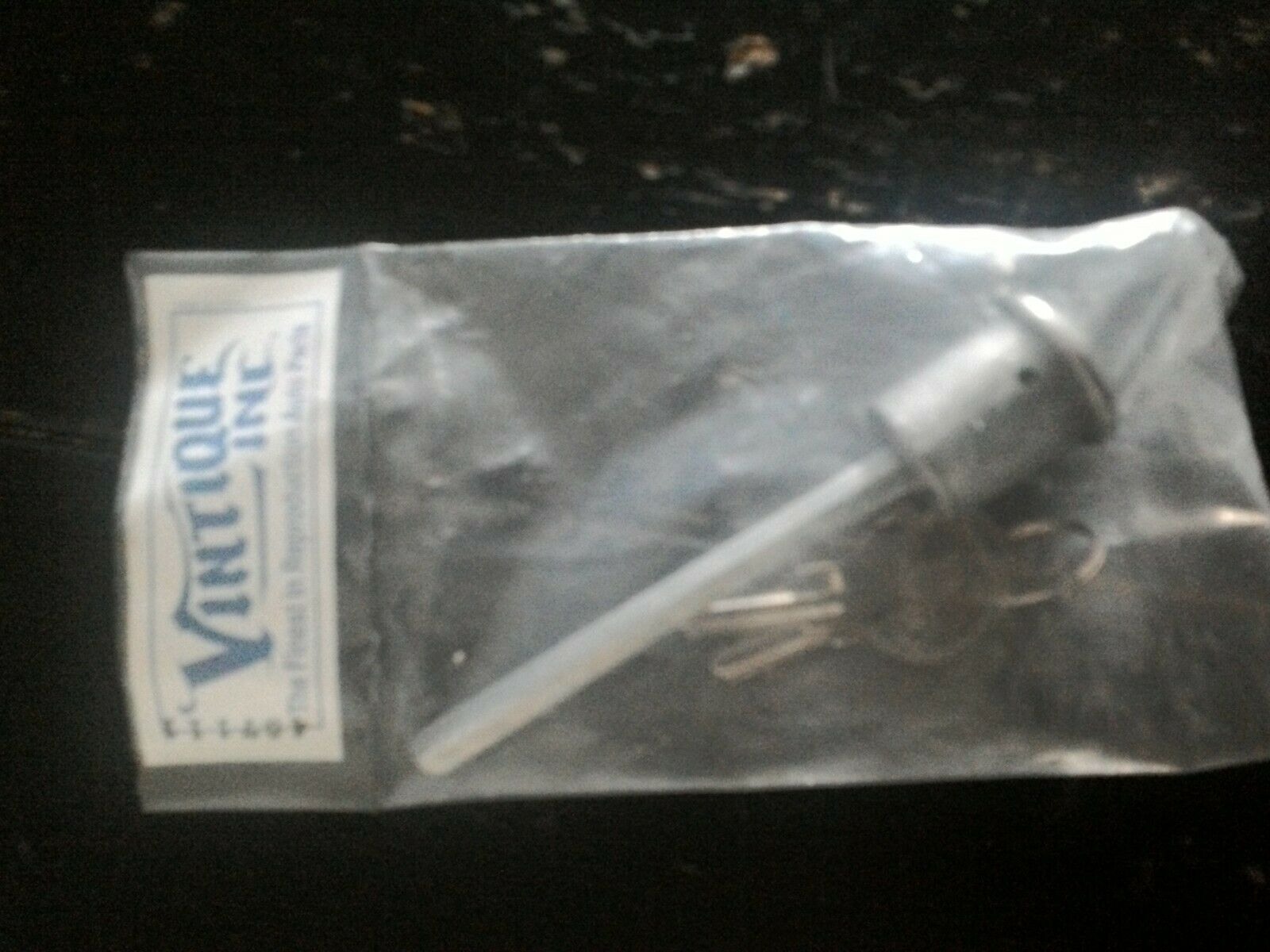
0 -
How does door weather stripping fasten to the car? On the top over the doors, does a tadpole molding fit (sanddwich) under the roof rails and over the metal straps? I don't see any screw threads in the pilars to anchor to, so does it go onto the door edges?0
Categories
- 36.9K All Categories
- 113 Hudson 1916 - 1929
- 20 Upcoming Events
- 93 Essex Super 6
- 28.6K HUDSON
- 574 "How To" - Skills, mechanical and other wise
- 995 Street Rods
- 151 American Motors
- 180 The Flathead Forum
- 49 Manuals, etc,.
- 78 Hudson 8
- 44 FORUM - Instructions and Tips on using the forum
- 2.8K CLASSIFIEDS
- 608 Vehicles
- 2.2K Parts & Pieces
- 77 Literature & Memorabilia
- Hudson 1916 - 1929 Yahoo Groups Archived Photos

